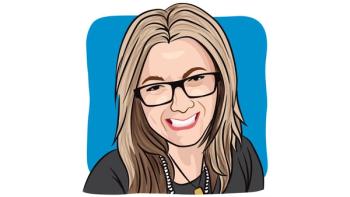
Undergoing Treatment for Ovarian Cancer
Transcript:
Shubham Pant, M.D.: Doña, tell us a little about your treatment journey if you don’t mind sharing that. What kind of treatments did you go through? After you met Dr. Eskander, what were the next steps for your treatment?
Doña Harman: After my debulking surgery, I was told I had no evidence of disease. So it was optimal, and I began chemotherapy with Taxol and carboplatin. And I also went on a clinical trial with a PARP inhibitor that Dr. Eskander felt was a really good match for me, and I did dose-dense therapy. I was scheduled to do 18 chemotherapy treatments — infusions — and I was able to complete 17 of them.
Shubham Pant, M.D.: Very nice.
Doña Harman: Yes.
Shubham Pant, M.D.: That’s OK. I think that’s a lot. Dr. Eskander, tell us a little about therapy for ovarian cancer. What are the treatment steps that you take from the beginning for staging the cancer, and then what are the treatment options available for patients out there?
Ramez N. Eskander, M.D.: The first fork in the road is really whether or not you’re able to proceed with primary surgery or if you need to start with what we call neoadjuvant chemotherapy, and that depends on many factors. It depends on how physically fit a patient is, whether they have medical conditions that would preclude a big operation. And that’s predominantly based on clinical exam and imaging. If you feel like you can successfully remove all the tumor, which is the goal of a primary surgery, to remove all the visible disease, then you can proceed with a primary operation again in the context of a medically fit patient.
If, for whatever reason, the disease is unresectable — if there’s widely metastatic disease in the lung or if there are multiple lesions in the liver — then for those patients, you would get a biopsy to confirm their disease and also help you figure out the germline and somatic BRCA status now, which is still relevant. And then you would offer them primary neoadjuvant chemotherapy, and that could be done on a clinical trial if one is available at the institution where the patient is being treated or with, again, standard carboplatin-paclitaxel. And some people incorporate a drug called bevacizumab or Avastin in that setting. And if you operate first, then once surgery is done you talk about treatment. Again, those treatment options are clinical trial or carboplatin-paclitaxel with or without bevacizumab therapy, and then also the PARP inhibitor option for appropriate patients who have a BRCA1 or BRCA2 alteration.
Shubham Pant, M.D.: So it’s tailored toward every patient with what you do. There could be different options. There could be some targeted therapies like you’re talking about. There could be chemotherapy to get them through their surgery with a combination of the above. Dr. Hirst, for patients going through chemotherapy, what kind of emotional and psychological changes do they go through, and how can patients deal with that?
Jeremy Hirst, M.D.: What we find is for a lot of patients there’s still the fear and the worry leading up to meeting with their physician. Getting a plan, things start to calm down, and then there’s again another peak of anxiety before you have surgery, before you start chemotherapy. Then once things start to happen, for many folks there’s a sense of, OK, now we’re on the road, now we’re doing something about it. The cancer was still growing or still attacking me, but now we’re doing something about it, and often a sense of relief can come.
For folks who have a lot of side effects to chemotherapy or have a more complicated post-operative course, physical symptoms can crop up. And when we’re not feeling well physically, that tends to also impact our emotional strength and our emotional tolerance. We find that treating those — whether it’s nausea, pain, constipation, the basics — if we can keep our physical self feeling well, we have a little more strength emotionally to deal with the ups and downs that we’re facing.
Shubham Pant, M.D.: Doña, can you share with us some ups and downs that you faced? How did you deal with them while you were undergoing chemotherapy or therapy in general?
Doña Harman: Well, one of the things I did, I wanted to maintain as much as I could a sense of normalcy. And part of that was, I was told I would be able to keep my hair. And so I did a cold-cap treatment.
Shubham Pant, M.D.: Nice.
Doña Harman: Seventeen times.
Shubham Pant, M.D.: And that is intense.
Doña Harman: You really need to want that hair.
Shubham Pant, M.D.: You were determined.
Doña Harman: I was, but it was nice. For me, my hair is part of my identity, and I really respect women in whatever journey they decide to go on, but for me it was really nice to go out on a Friday night. My husband I always go to the movies on the weekend, and to just feel like myself, I could kind of put cancer in a box. That was a nice thing: to find out that you don’t have to lose your hair. I probably lost about 20%. That’s what my hairdresser said. So that was a perk.
But a challenge was probably some complications that I had. I had two intestinal obstructions due to scar tissue that required hospital and surgery during the time I was having chemotherapy. And that resulted in dose delays. Also because of the toxicity, I had dose reductions, and so those weighed on me because I felt that if we’re going to do this, let’s do it — just give me the stuff, and let’s really go to battle. That weighed on me because I worried that my body wasn’t fighting hard enough, and they were having to treat me more and more carefully.
Shubham Pant, M.D.: That’s fairly common. When we test these drugs, they’re just tested in a small number of patients, and then we give them to hundreds and thousands of patients. And there has to be truly per-patient dose adjustment and that’s where expertise of people like Dr. Eskander, who can see what you can tolerate and dial the chemotherapy with your body’s reaction, comes in.
Transcript Edited for Clarity




